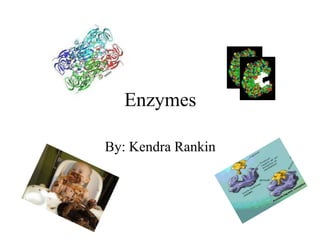
Enzymes triple science
- 2. What are enzymes? Enzymes are large protein molecules which are made up of long chains of amino acids that is folded to produce a molecule with a specific 3D shape. Enzymes can be used in our bodies as biological catalysts and in industry also.
- 3. Enzymes in Clothes and Dishwashing Detergents Enzymes can be used as detergents to remove stains such as grass, sweat and food from clothes. These biological washing powders contain proteases and lipases. These enzymes break down the proteins and fats in the stains. They help give cleaner washes and they work better than non-biological detergents at lower temperatures. This is because the enzymes work best at lower temperatures, they denature if the water is too hot. This means you loose less electricity. (Dishwasher detergents contain enzymes that disgest cooked-on proteins like eggs, which are often hard to remove.)
- 4. Advantages and Disadvantages of using Enzymes Enzymes can solve industrial problems like the need for speeding up the many reactions that need high temperatutes and pressures to make them go fast enough to produce the products needed which include the use of expensive equipment and requires a lot of energy. They catlyse reactions at relatively low temperatures and normal pressures. Enzyme-based processes are therefore often fairly cheap to run. One problem with enzymes is that they are denatured at high temperatures, so the temperature must be kept down (usually below 45○C). The pH also needs to be kept within carefully controlled limits that suit the enzyme. It costs money to control these conditions. Many enzymes are also expensive to produce. Whole microbes are relatively cheap, but need to be supplied with food and oxygen and their waste products removed. They use some of the substrate to grow more microbes. Pure enzymes use the substrate more efficiently, but they are also more expensive to produce.
- 5. Enzymes in Baby Food and Industry Pure enzymes have many uses in industry. Proteases are used to make baby foods. They 'predigest' some of the protein in the food because babies when they first start eating solid foods, they are not very good at digesting it. Treating the food with protease. Enzymes makes it easier for a baby's digestive system to cope with. Carbohydrates are used to convert starch into sugar (glucose) syrup. Starch is made by plants like corn and it is very cheap. Using enzymes to convert this plant starch into sweet sugar provides a cheap source of sweetness for food manufactures. It is also important for the process of making fuel (ethanol) from plants.
- 6. Enzymes for Slimming Aid Enzymes can be used for slimming aid because the enzyme isomerase is used to change glucose syrup into fructose syrup. Glucose amd fructose contain the same amount of energy (1700kJ or 400kcal per 100g). Fructose is much sweeter than glucose and so smaller amounts are needed to make food taste sweet. The food tastes sweet but contains fewer calories which helps you to lose weight.
- 7. Enzymes in Medical Diagnosis If your liver is damaged or diseased, some of your liver enzymes may leak out into your bloodstream. If your symptoms suggest your liver isnt working properly, doctors can test your blood for these enzymes. This will tell them if your liver is really damaged.
- 8. Enzymes used to Control Disease People who have too much glucose in their blood, as a result, they also get glucose in their urine. One commonly used test for sugar in the unrine relies on a colour change on a test strip. The test contains a chemical indicator and an enzyme. It is placed in a urine sample. The enzyme breaks down any form of glucose found in the urine. The strip changes colour if the products of this reaction are present. This shows that glucose was present in the original sample.
- 9. Enzymes used to Cure Diseases If your pancreas is damaged or diseased it cannot make enzymes. So, you have to take extra enzymes - particulary lipase - to allow you to digest your food. The enzymes are in special capsules to stop them being disgested in your stomach. If you have a heart attack, an enzyme called streptpkinase will be injected into your blood as soon as possible. It dissolves clots in the artries of the heart wall and reduces the amount of damage done to your heart muscle. An enzyme is being used to treat a type of blood cancer in children. The cancer cells cannot make one particular amino acid. They need to take it from your body fluids. The enzyme speeds up the breakdown of this amino acid. The cancer cells cannot get any and they die. Your normal cells can make the amino acid so they are not affected.
- 10. The End